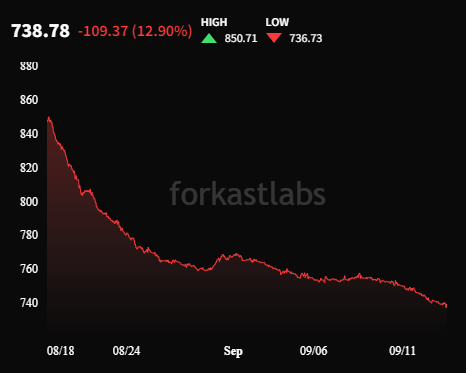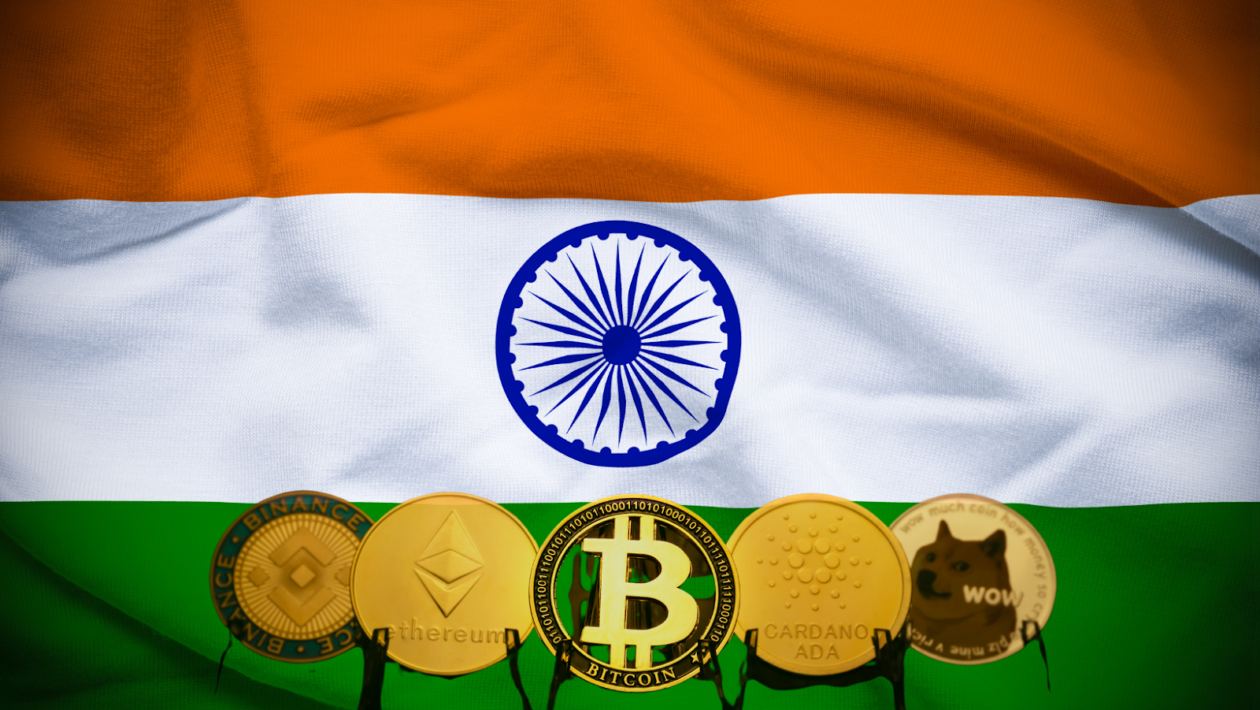In this issue
- Shakeup at Binance.US
- NFT: Ethereum projects at risk
- India’s crypto stand: Decision looms
From the Editor’s Desk
Dear Reader,
We here at Forkast are big fans of creative destruction, the theory advanced by economist Joseph Schumpeter in which new innovations disrupt and replace established practices. In other words, out with the old, in with the new.
Events in the cryptocurrency space in recent days may be pointing that way, as the world’s biggest crypto exchange hemorrhages executive leadership and the fuzzy outlines of international norms for the industry begin to sharpen following the G20’s support for recommendations on regulation.
In and of themselves, these two developments aren’t a sufficient basis to conclude that the industry has reached a transformative, Schumpeterian moment, trading its often turbulent times on the fringes of finance for a more secure spot.
However, given the direction of travel more broadly – reflected in increasingly sure-footed digital asset regulation in such key jurisdictions as Singapore and Hong Kong, a much more solid industry consensus around what’s deserving of investment, and not least in the promise of a well-defined framework of crypto rules tailored for India as it concludes its G20 presidency – change seems to be in the air.
In this industry, we like to think that change comes quickly – and indeed it often does, although frequently not by design. But almost a year since the implosion of FTX – an event that arguably changed the crypto landscape more than any other in recent times – the industry is still dusting itself off, demonstrating that more fundamental shifts take time. As, indeed, they do in any sector.
One thing that hasn’t changed is the upstart nature of crypto, and it isn’t likely to anytime soon, no matter how much it becomes an unremarkable part of the financial ecosystem.
Yet signs that the digital asset revolution is entering a new phase of its development are abundant. If the industry can avoid blowing itself up à la the likes of FTX and Terra LUNA, and continue to develop the creative component of Schumpeter’s thesis, its growing maturity – regulation and all – is to be welcomed.
Until the next time,
Angie Lau,
Founder and Editor-in-Chief
Forkast.News
1. Winds of change


Brian Shroder, the chief executive officer of Binance U.S., has departed the company as the U.S. affiliate of the world’s largest cryptocurrency exchange laid off one-third of its staff, or more than 100 employees.
- This downsizing will provide Binance.US “more than seven years of financial runway,” a spokesperson of the firm told Forkast in an email statement. Norman Reed, the company’s chief legal officer, has assumed Shroder’s position on an interim basis.
- Schroder’s departure came amid regulatory challenges in the U.S., with the layoff being an “unfortunate example” of the impact from “the SEC’s aggressive attempts to cripple our industry,” the spokesperson added.
- Binance U.S. has been dealing with growing regulatory pressures in the U.S. this year. In June, the company was sued by the Securities and Exchange Commission (SEC) for allegedly violating securities regulations.
- Binance, the parent company, also faces regulatory scrutiny from the U.S. The Commodity Futures Trading Commission filed a civil suit against the exchange and founder Changpeng Zhao in March for operating an “intentionally opaque” business to take advantage of “regulatory arbitrage.” The exchange is also reportedly being investigated by the U.S. Department of Justice, which could pursue fraud charges against it.
- Last week, Binance’s global head of product Mayur Kamat resigned from the company, according to Reuters.
Forkast.Insights | What does it mean?
The cryptocurrency market, notoriously volatile and seen by some as a harbinger of wider economic trends, offers a tantalizing snapshot of current financial winds. Binance.US’ decision to downsize, stemming not just from the ebbs of a crypto bear market but also its intertwined legal complexities, serves as a poignant indicator of shifting sands in the financial world. With the company boasting of a “seven year financial runway,” it would seem that even the giants of the crypto realm are donning a cloak of caution.
Yet, while digital currency platforms take precautionary steps, the broader U.S. economic narrative is engrossed with the menace of inflation. The very mention of the term ‘inflation’ sends tremors through the spine of any economy, and the U.S. is no exception. A 3.7% rise in consumer prices over the past year, exacerbated by surging gasoline prices, has understandably sounded alarm bells.
The Federal Reserve has made bold strides to counteract this specter. By hiking interest rates from near-zero in 2022 to a staggering 5.25%-5.5%, levels unseen since the dawn of the 21st century, the Fed’s intent is clear: to temper inflation and ensure a safe landing.
But this safeguard comes at a cost. With the consequential surge in mortgage and credit card interest rates, borrowing has transformed from a benign affair into a more daunting endeavor. This shift has understandably ruffled the feathers of investors and business magnates, who worry that such steep hikes could push the economy into the chasm of recession.
Despite these dramatic monetary maneuvers, the U.S. job market has remained resilient. Wages continue to surge upward, hinting at an economy that isn’t ready to bow down just yet. This juxtaposition brings financial behemoths like BlackRock and Amundi hinting at cracks appearing in the U.S. economy, according to the Financial Times. Vincent Mortier, chief investment officer of Amundi, claims that the possibility of a recession in the U.S. is “very high.” Conversely, the undeniable vitality of the job market suggests a U.S. economy that’s still basking in the glow of its heyday.
2. On shaky ground


The declines in Ethereum’s NFT ecosystem have outpaced those in Polygon, Solana, and Cardano, with the impact of OpenSea’s creator fees policy, SEC charges against NFT projects, and controversy in major projects driving down the broader NFT market.
- Since Aug. 18 (the date of OpenSea’s policy announcement), the Forkast ETH NFT Composite has lost 12.9%, compared to declines of 7.28% on Cardano, 6.78% on Solana, and 3.9% on Polygon.
- The Forkast 500 NFT Index fell 15.27% in that period, reflecting the impact of Ethereum NFTs.
- The SEC’s war on NFTs has disproportionately impacted Ethereum, with the SEC’s first two lawsuits against Impact Theory and the Stoner Cats projects both being on Ethereum.
- Ethereum’s top collections were hit by negative news over the past few weeks, driving down the value of NFTs across the ecosystem. DeGods’ poor “downgraded art”, WreckLeague failing to mint out, the Nouns DAO fork, and US$1 million being stolen from the Milady Maker DAO’s treasury have had ripple effects across the Ethereum NFT landscape.
Forkast.Insights | What does it mean?
The bigger they are, the harder they fall, and there’s no denying that Ethereum is the big kahuna when it comes to NFTs. From its astronomical peak of value in 2022 to the post-bubble market we now find ourselves in, Ethereum’s fall from the top has hit harder and has done more damage to collectors than anything we’ve seen on other blockchains. From some perspective, Ethereum NFTs have traded for over US $44 billion, while their closest competitors saw only 10% of those sales (Ronin US$4.2 billion, Solana US$4.1 billion, Flow US$3.5 billion, Polygon US$1.2 billion, and Cardano US$606 million)
Blow by blow, hit by hit, much of what was built with NFT sales is being knocked down by new negative events that just keep coming in. Each story and event ripples across the rest of the market, driving sentiment down and priming each collection for their own collapse once they hit any bumps in the road. Ethereum is the biggest target of all and has already shown us exactly how the market collapse will play out.
In the past few weeks we have had two prime examples that showcase exactly how a project tumbles down the mountaintop. The Nouns, one of Ethereum’s top collections from 2021, hit a patch of turbulence this month that has altered the course of their future. With their DAO’s members voting to fork, existing NFT holders have been given an opportunity to exit the project, minus their NFT, but with their share of the treasury. Since the NFT market has declined, and the supply of Nouns NFT increases by the day (a built-in mechanic where 1 Noun is minted every day, forever), the value of Nouns on secondary markets has fallen drastically.
Members have an easy decision, take 30+ ETH now from the DAO, 20-25 ETH on secondary markets, or hold for years and hope the value exceeds what they can get today. Seems to be an easy decision, and 40% of Nouns are now leaving the DAO. The Nouns’ treasury has now lost over 35% of its holdings (down to 17,000 ETH from 28,000), signaling a loss in confidence in both the project and the broader market.
Milady Maker, one of the few PFP collections on Ethereum to actually gain value over the bear market, finally faced reality when one of their own developers stole US$1 million from the project’s treasury. While legal options may ultimately be able to recover the funds, this type of news causes a rush for the exit, because nobody wants to be the last man holding the NFT in this illiquid market. Miladys had reached as high as 4.5 ETH this summer, and this week were selling for just 2.1 ETH.
It feels like we’re still at the true start of the market collapse. There’s just not enough projects that have fallen to zero yet. But as predicted weeks ago, more charges are coming from the SEC and its target has become clearer. With their most recent charges against the Stoner Cats the SEC has declared that selling NFTs to raise funds and promoting a secondary market means you’re likely in the crosshairs. Like a Jenga puzzle balancing on one peg, I think we’re just one big story away from the big collapse.
3. India to take a stand


India will decide its position on crypto assets in the coming months, and take reference from the international consensus formed at the recent G20 summit, said the South Asian nation’s Secretary of the Department of Economic Affairs, Ajay Seth.
- The G20 summit under India’s presidency has brought about a “very clear and comprehensive understanding” of the policy framework and risk assessment of crypto, as well as an endorsement from global leaders of India’s previous initiatives to regulate stablecoins and unbacked crypto assets, Seth said in an interview with CNBC TV18 on Sunday.
- “Based on the consensus which we have been able to achieve or rather build, we will be considering those recommendations very carefully and decide our own policies and thereafter take further action,” he said, noting that New Delhi’s position on crypto assets will be decided in coming months.
- India’s crypto industry has been troubled by a harsh stance from the government, which imposes a 30% tax on all crypto income and has expanded the anti-money laundering measures to the digital asset industry.
- The summit that ended on Sept.10 could signal a change in India’s crypto policies. When asked about the Reserve Bank of India’s 2022 proposal to outright ban cryptocurrencies, Seth said the crypto industry “is not to be seen in that binary,” and that the Indian government will now consider its own position in reference to what global leaders have agreed with.
- Meanwhile, some analysts questioned whether the G20 consensus could substantially impact crypto regulation in member states. “G20 is not powered to make binding regulations,” Amitendu Palit, senior research fellow at the National University of Singapore, told Forkast.
- The bloc can, at best, provide policy suggestions and directions for global adoption and the regulations would have to be implemented by the member states, Palit said.
Forkast.Insights | What does it mean?
India’s official stance on cryptocurrencies has been the subject of intense attention in the crypto industry for a number of years now. The country has also been a source of serial disappointments as its government has imposed hefty taxes on crypto transactions, its central bank has attempted to throttle the industry, enforcement action has been taken against exchanges, and lawmakers have toyed with the idea of banning crypto altogether.
So, when India assumed the presidency of the G20, with an apparent determination to allow the industry to thrive under a consensus set of rules that could be adopted internationally, industry observers might have been forgiven a flush of optimism.
However, now that New Delhi has chalked up nine months at the G20’s helm, with little to show for it in terms of its own position on crypto other than a wordy pronouncement by its economic affairs secretary that the government will draw up a regulatory framework “in the coming months,” we’re left wondering just what’s coming down the pipe.
On balance, it seems unlikely that the government will reverse course, given the levels of hostility toward crypto expressed by its central bank and various authority figures. But New Delhi appears – unlike Beijing – to understand that crypto can’t simply be wished away, and from that the industry might take some comfort.
Indeed, the joint policy paper commissioned by the G20 and published by the International Monetary Fund and the Financial Stability Board explicitly warns countries against imposing bans on crypto. Both bodies, however, are noted crypto skeptics, meaning that no matter how commonsense any Indian framework is that emerges from the consultative exercise, it’ll be likely to cleave toward a more restrictive line than many in the industry would doubtless prefer.
Whatever comes of India’s apparent final push to get the industry into compliance with its forthcoming rules, at least in a democracy – even one as flawed as India’s – bad regulations can be changed in response to public pressure. Try that in a place like China.
- SEO Powered Content & PR Distribution. Get Amplified Today.
- PlatoData.Network Vertical Generative Ai. Empower Yourself. Access Here.
- PlatoAiStream. Web3 Intelligence. Knowledge Amplified. Access Here.
- PlatoESG. Automotive / EVs, Carbon, CleanTech, Energy, Environment, Solar, Waste Management. Access Here.
- PlatoHealth. Biotech and Clinical Trials Intelligence. Access Here.
- ChartPrime. Elevate your Trading Game with ChartPrime. Access Here.
- BlockOffsets. Modernizing Environmental Offset Ownership. Access Here.
- Source: https://forkast.news/binance-us-ceo-calls-it-quits-amid-major-layoffs/



